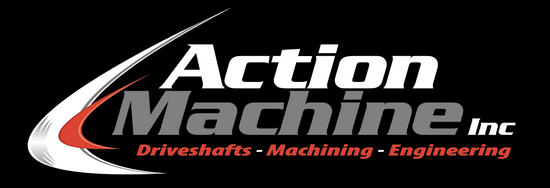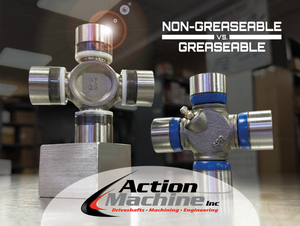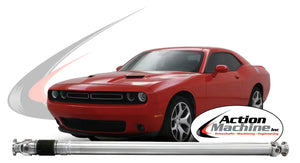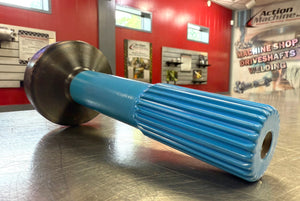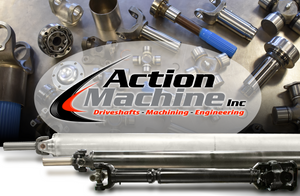The Driveshaft Journal
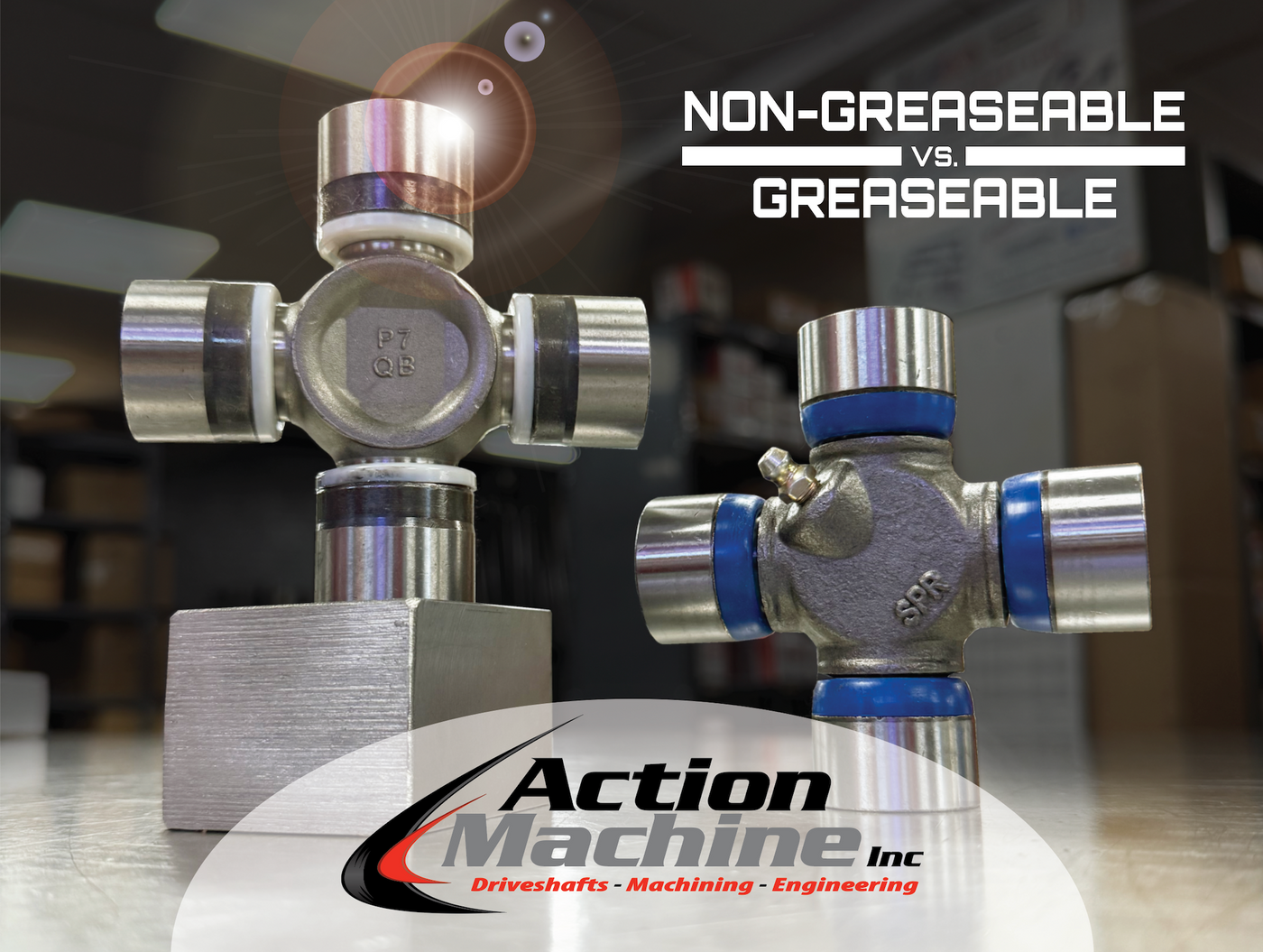
The Ultimate U-Joint Showdown: Greaseable vs. Non-Greaseable
|
If you've ever found yourself elbow-deep in a driveshaft rebuild, staring at a U-joint and wondering, "Should I go greaseable or non-greaseable?" — you’re not alone. This debate has been rumbling through garages, shops, and forums for decades. And like any good showdown, both sides have their loyal fans. But here at Action Machine, we’ve got skin in the game. We build driveshafts for everything, and we’ve made our choice: Non-greaseable U-joints, every time (when applicable). |
IN THIS CORNER: Greaseable U-Joints |
These are your old-school, blue-collar warriors. They come with a zerk fitting, a little nipple where you can pump in fresh grease, and they’ve been around forever. Inside, there’s a cross-drilled channel that carries grease into the bearings.

Pros:
- You can flush out contaminants if water, mud, or grit gets in.
- With regular maintenance (every 3,000-5,000 miles), they can last a long time, emphasis on regular.
- Some guys just like the routine. Grease gun in hand, tunes on in the garage, it’s therapy.
Cons:
- That cross-drilled hole? It weakens the joint just enough to matter under stress.
- If you forget to grease them? You’ll wear them out fast.
- The zerk itself can be a failure point, or worse, an excuse to skip maintenance.
Our Pick for Greaseable Fans
If you’re a diehard greaseable fan, we usually recommend U-Joints similar to the Spicer 5-1310-1X. It’s one of the stronger greaseable options because it uses a thrust washer (instead of a needle thrust), has no 45° cross-drill to weaken the cross, and still incorporates a multi-lip seal to help keep contaminants out and grease in.
AND IN THIS CORNER: Non-Greaseable U-Joints |
These are the sealed, stealth assassins of the driveshaft world. No zerk. No maintenance. No apologies.

Pros:
- Stronger cross section, because there’s no hole drilled for grease.
- Higher fatigue life, especially under torque, RPM, or off-road abuse.
- Zero maintenance. Seriously, you never have to grease them.
- Less mess, fewer mistakes, no schedule to keep.
Cons:
- If the seal fails, there's no saving it, you’ll have to replace the joint.
- You can’t flush out grit once it’s in.
- You lose the excuse to hang out in the garage with a grease gun.
Our Choice: Spicer Life Series
When we say “non-greaseable,” we’re almost always talking about the Spicer Life Series. These U-joints are cold forged for strength, use a synthetic thrust washer that eliminates friction and prevents end galling, and have a multi-lip seal that keeps grease in and contaminants out. That seal design also prevents the heat buildup that typically breaks down grease. They’re engineered to be stronger, cleaner, and longer-lasting, exactly what we want in a driveshaft that sees real-world abuse.
What’s Best for You? |
||
| You… | Go With… | Because… |
|
Like wrenching & have a grease schedule |
Greaseable |
You’ll keep ‘em alive with love and lube |
|
Want stronger, no-fuss durability |
Non-Greaseable |
One less thing to forget, and stronger where it counts |
|
Drive off-road or in water |
Non-Greaseable |
Sealed units resist contamination better |
|
Are building a performance shaft |
Non-Greaseable |
Cleaner look, cleaner build, cleaner conscience |
What We Use at Action Machine
Here at Action Machine, we’ve seen the inside of tens of thousands of U-joints, and we’ve learned what holds up and what doesn’t.
That’s why, on every new driveshaft we build (when applicable), we spec non-greaseable Spicer Life Series U-joints.
Why?
Because greaseable joints, while serviceable, come with a compromise:
A small cross-drilled hole for lubrication might keep it greased, but it also becomes a stress riser, a weak point that can fail under heavy load.
By eliminating that internal channel, non-greaseable joints offer a stronger cross, longer fatigue life, and zero-maintenance reliability. They’re built to last, and built to be forgotten, in the best way possible.

Our Final Word

Let’s call it like it is:
- Greaseable U-joints are like cast iron skillets, great if you take care of them.
- Non-greaseable U-joints are like stainless steel, strong, sleek, and effortless.
If you love to tinker, go greaseable. But if you’d rather never think about your U-joint again until the odometer’s rolled over twice?
Go sealed. Go strong. Go non-greaseable.
That’s the Action Machine way.
A Quick Note on Quality
Not all U-joints are created equal. You can find a greaseable from one brand that holds up great, and another that’s weak and poorly made. That’s why at Action Machine, we stick with trusted brands like Spicer and Neapco whenever possible. They consistently deliver the strength, precision, and reliability we want in every driveshaft we send out the door.

Let’s Build Something That Lasts
Whether you're building a race rig, hauling heavy, or upgrading from stock. we're here to help you spec the perfect driveshaft with the right U-joint for the job.

Built in-house
Balanced to perfection
Backed by people who know U-joints better than they know their neighbor’s names
- Kevin McIlvaine
- Tags: The Ultimate U-Joint Showdown: Greaseable vs. Non-Greaseable
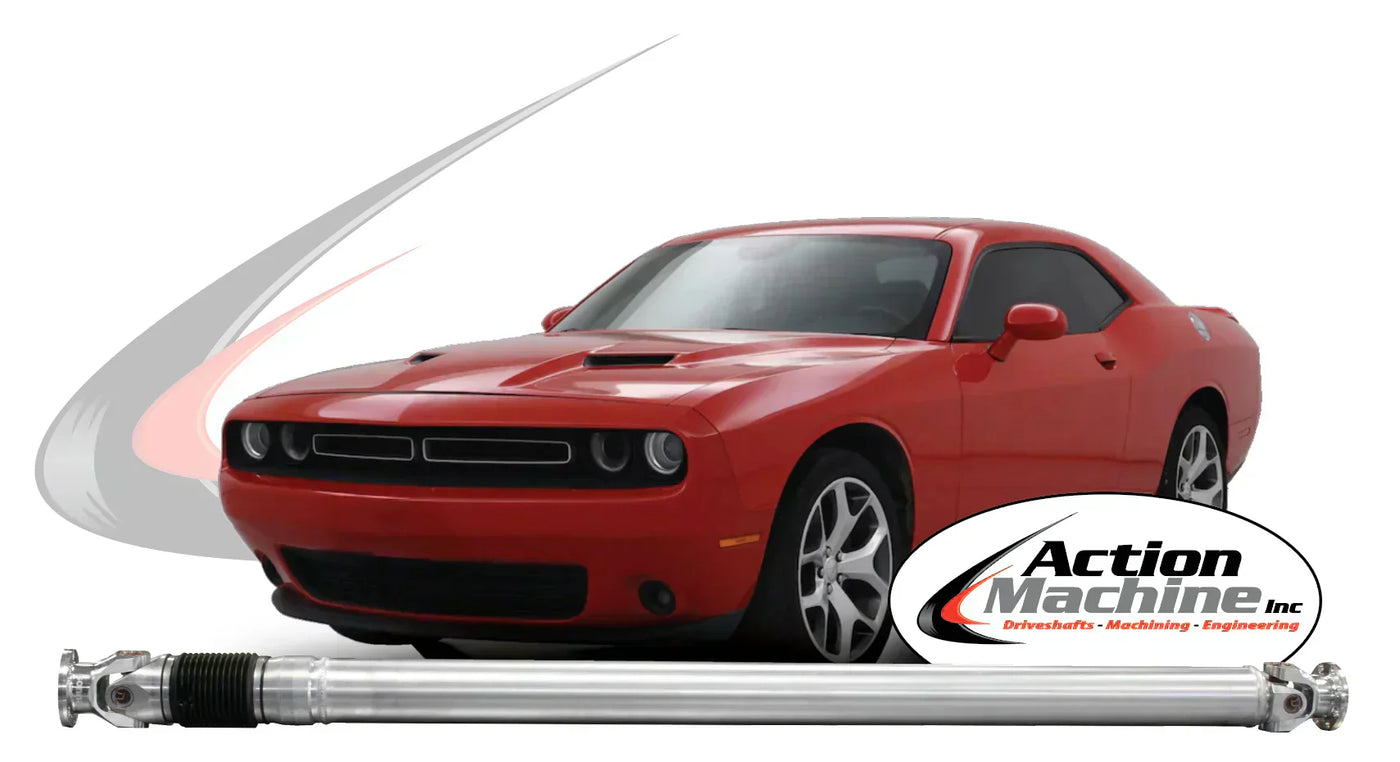
A Better Driveshaft for Your Chrysler 300, Charger, or Challenger
A Better Driveshaft for Your Chrysler 300, Charger, or Challenger.
If you’ve owned a Chrysler 300, Dodge Charger, or Dodge Challenger for any length of time, you’ve probably heard about the factory driveshaft issues. The stock 2-piece shaft is known to cause problems, whether it's vibration, carrier bearing failure, or CV joint wear. At Action Machine, we’ve built a better option: a one-piece aluminum driveshaft that solves those problems and delivers long-term peace of mind.
- Kevin McIlvaine
- Tags: One Piece Conversion Driveshafts
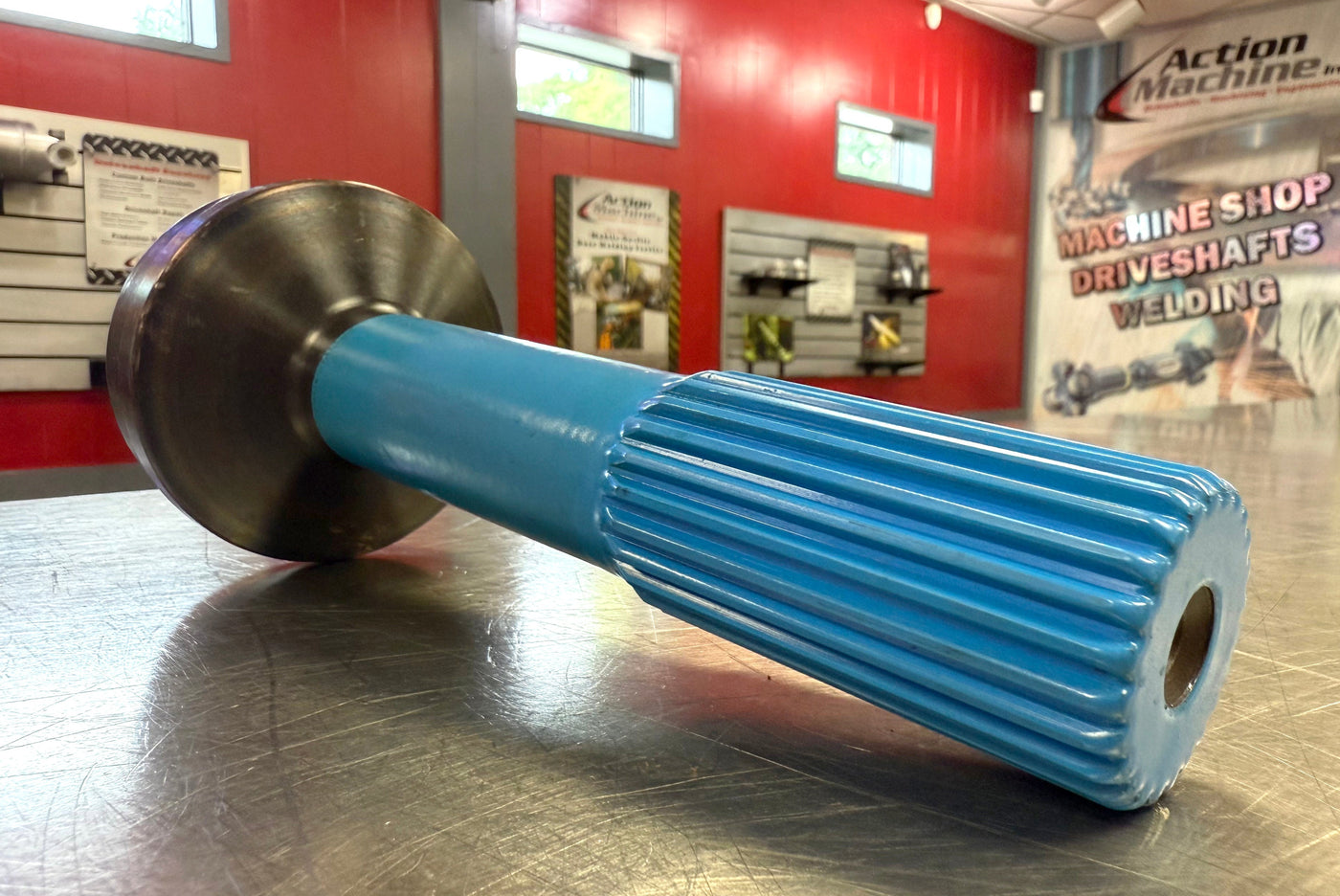
What Is That Blue Coating On My Driveshaft Spline? (Hint: Don’t Remove It)
“Is that paint?”
“Should I scrape this off before installing?”
“Is it just for shipping?”
At Action Machine, we hear these questions often, especially from DIYers or first-time buyers. That blue film isn’t paint or plastic. It’s called Glidecote, and it plays a critical role in extending the life and performance of your driveshaft.
- Kevin McIlvaine
- Tags: Glidecote
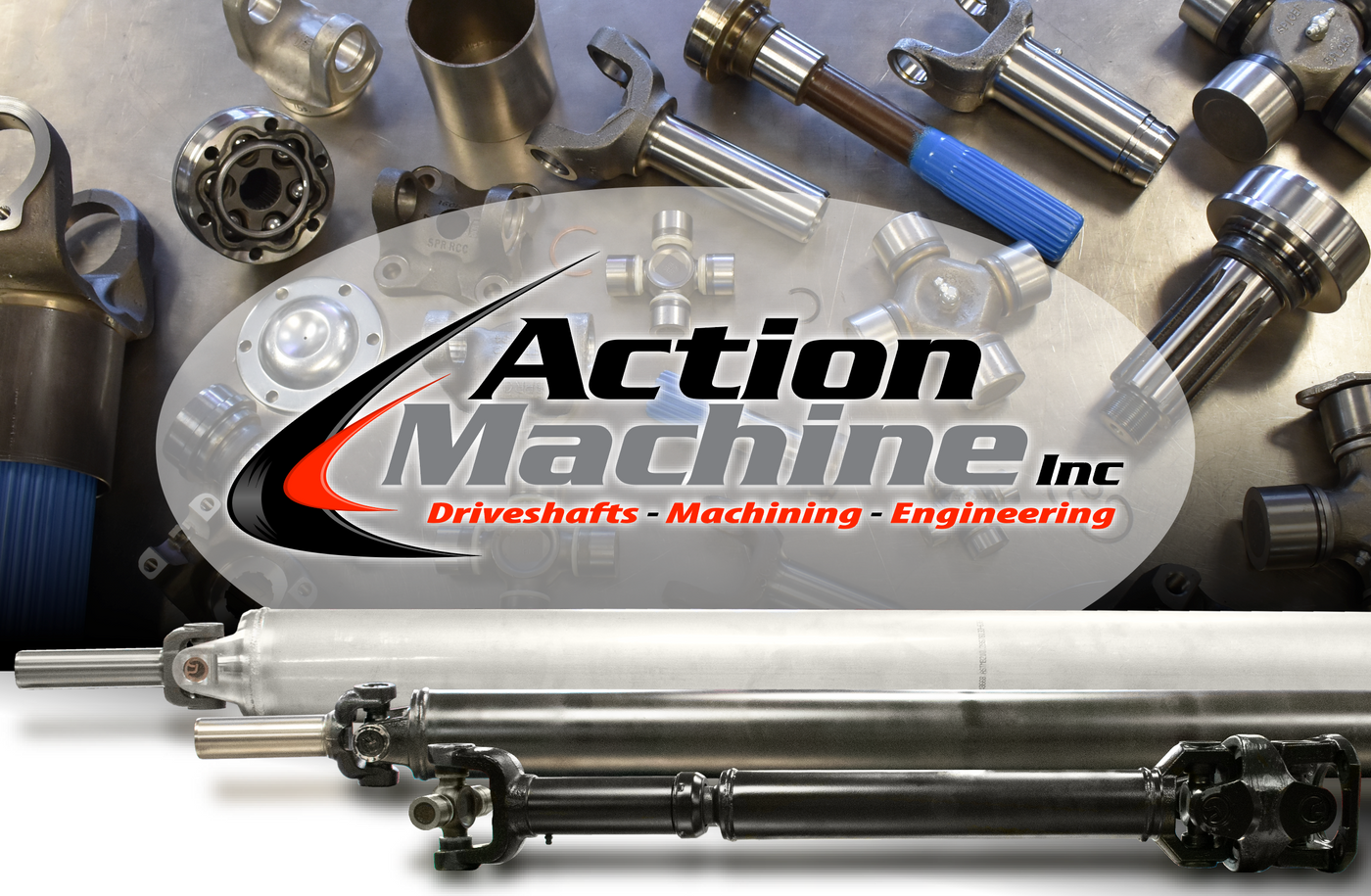
Aluminum vs. Steel Driveshafts: Which is right for your application?
Aluminum vs. Steel Driveshafts: Which Is Right for Your Application?
Choosing the right driveshaft material comes down to application, performance goals, and budget. At Action Machine, we build both aluminum and steel driveshafts and help customers select the right option based on length, torque, weight, and critical speed. Both materials offer unique strengths, and the best choice...
- Kevin McIlvaine
- Tags: Aluminum Vs. Steel Driveshafts
